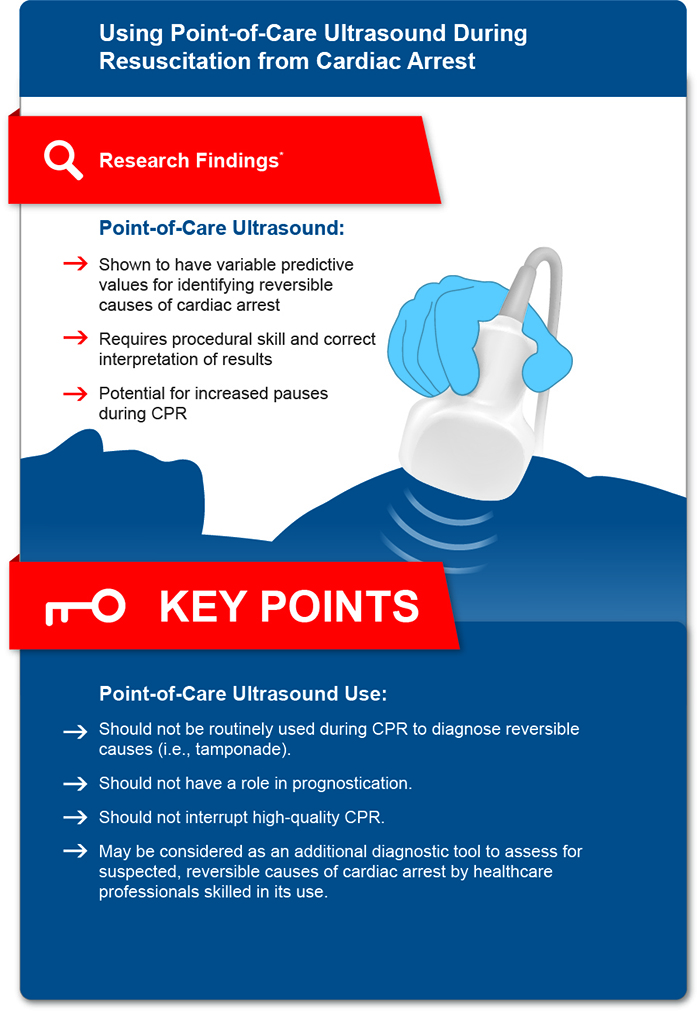Intra-Cardiac Arrest Diagnostic Interventions
Intra-Cardiac Arrest Point-of-Care Diagnostic Ultrasound
Last Full Review: ILCOR 2022
Point-of-care ultrasound is sometimes used during cardiac arrest to search for a reversible cause of arrest. Previous reviews have determined that point-of-care ultrasound should not have a role in prognostication. However, is there evidence to support its use as a diagnostic tool?
Red Cross Guidelines
- Point-of-care ultrasonography may be considered by healthcare professionals competent in its performance as an additional diagnostic tool for assessment of suspected reversible etiologies of cardiac arrest but should not interfere with resuscitation or providing high-quality cardiopulmonary resuscitation.
- Point-of-care ultrasonography should not have a role in prognostication for cardiac arrest.
Evidence Summary
For adults in cardiac arrest in any setting, is there any finding on point-of-care ultrasound during cardiopulmonary resuscitation (CPR), compared with any external confirmatory test, process or procedure other than the original point-of-care ultrasound, that accurately identifies a specific etiology of cardiac arrest? A 2022 International Liaison Committee on Resuscitation (ILCOR) systematic review (Reynolds et al. 2022a, 54) and Consensus on Science with Treatment Recommendations (Wyckoff et al. 2022, e483; Reynolds et al. 2022b) sought to evaluate evidence to answer this question. Data available from a subset of 31 patients from an observational study (van der Wouw et al. 1997, 780) with 48 in-hospital cardiac arrests was used to estimate sensitivities and specificities of point-of-care ultrasound to identify cardiac tamponade (sensitivity, 1.00; 95% CI, 0.29–1.00; specificity, 1.00; 95% CI, 0.88–1.00), pulmonary embolism (sensitivity, 1.00; 95% CI, 0.16–1.00; specificity, 0.97; 95% CI, 0.82–0.99) and myocardial infarction (sensitivity, 0.86; 95% CI, 0.57–0.98; specificity, 0.94; 95% CI, 0.71–0.99) (Reynolds et al. 2022a, 54; Reynolds et al. 2022b). Additional observational studies included in the review were used to estimate individual positive predictive values for cardiac tamponade, pericardial effusion, pulmonary embolism, myocardial infarction, aortic dissection and hypovolemia in small subsets of patients with cardiac arrest in any setting. The estimates of positive predictive value had very wide confidence intervals and were considered difficult to interpret. It was noted that all studies had a high risk of bias related to both selection bias and ascertainment bias, and most had verification bias. The authors also noted that there is evidence showing that point-of-care ultrasound may increase the length of pauses during chest compressions (Dabrowski et al. 2021; Reynolds et al. 2022b).

*Reynolds JC, Nicholson T, O’Neil B, Drennan IR, Issa M, Welsford M. Diagnostic test accuracy of point-of-care ultrasound during cardiopulmonary resuscitation to indicate the etiology of cardiac arrest: A systematic review. Resuscitation. Mar 2022;172:54-63. doi:10.1016/j.resuscitation.2022.01.006
Weak recommendations by ILCOR suggest against the routine use of point-of-care ultrasound during CPR to diagnose reversible causes of cardiac arrest. However, the recommendations by ILCOR suggest that if point-of-care ultrasound can be performed by experienced personnel without interrupting CPR, it may be considered as an additional diagnostic tool when clinical suspicion for a specific reversible cause is present. A good practice statement was also made that any deployment of diagnostic point-of-care ultrasound during CPR should be carefully considered and weighed against the risks of interrupting chest compressions and misinterpreting the sonographic findings (Wyckoff et al. 2022, e483; Reynolds et al. 2022b).
Insights and Implications
A previous ILCOR systematic review assessed the prognostic use of point-of-care ultrasound during CPR to predict clinical outcomes in adults with nontraumatic in-hospital cardiac arrest or out-of-hospital cardiac arrest (Berg et al. 2020, S92). The included studies reported a wide range of sensitivities and specificities for cardiac motion in association with favorable clinical outcomes, informing the Red Cross guidelines against the use of point-of-care ultrasound during CPR for prognostication. The Red Cross guidelines have been updated for clarity and to note that use of point-of-care ultrasound should not interfere with resuscitation or providing high-quality CPR. The guideline recommendation against the use of point-of-care ultrasound for prognostication remains unchanged.

